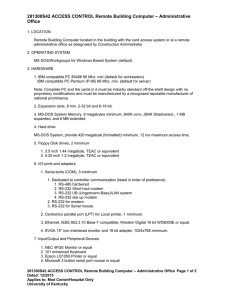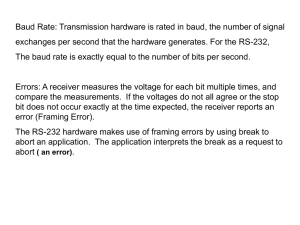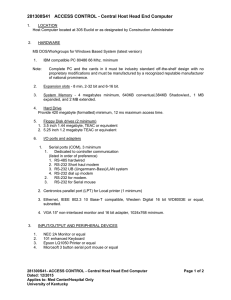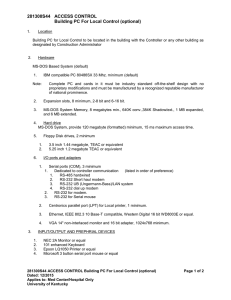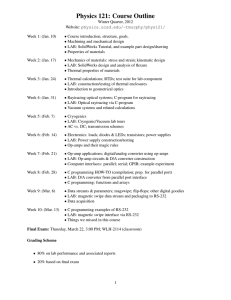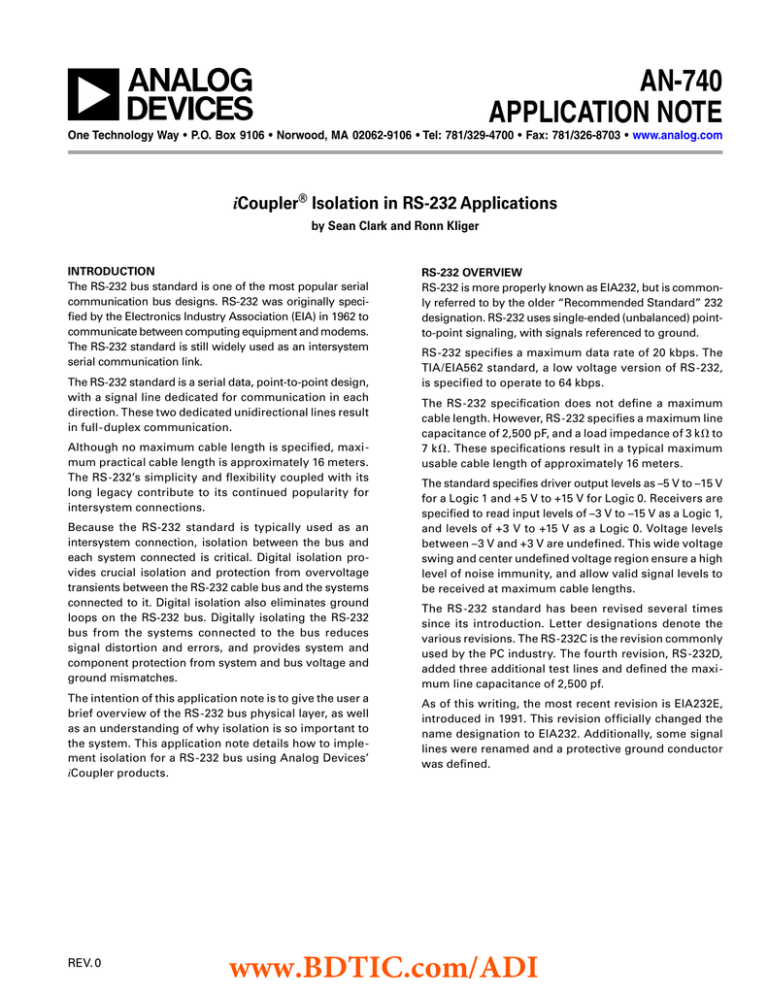
AN-740
APPLICATION NOTE
One Technology Way • P.O. Box 9106 • Norwood, MA 02062-9106 • Tel: 781/329-4700 • Fax: 781/326-8703 • www.analog.com
iCoupler® Isolation in RS-232 Applications
by Sean Clark and Ronn Kliger
INTRODUCTION
The RS-232 bus standard is one of the most popular serial
communication bus designs. RS-232 was originally specified by the Electronics Industry Association (EIA) in 1962 to
communicate between computing equipment and modems.
The RS-232 standard is still widely used as an intersystem
serial communication link.
The RS-232 standard is a serial data, point-to-point design,
with a signal line dedicated for communication in each
direction. These two dedicated unidirectional lines result
in full-duplex communication.
Although no maximum cable length is specified, maximum practical cable length is approximately 16 meters.
The RS-232’s simplicity and flexibility coupled with its
long legacy contribute to its continued popularity for
intersystem connections.
Because the RS-232 standard is typically used as an
intersystem connection, isolation between the bus and
each system connected is critical. Digital isolation provides crucial isolation and protection from overvoltage
transients between the RS-232 cable bus and the systems
connected to it. Digital isolation also eliminates ground
loops on the RS-232 bus. Digitally isolating the RS-232
bus from the systems connected to the bus reduces
signal distortion and errors, and provides system and
component protection from system and bus voltage and
ground mismatches.
The intention of this application note is to give the user a
brief overview of the RS-232 bus physical layer, as well
as an understanding of why isolation is so important to
the system. This application note details how to implement isolation for a RS-232 bus using Analog Devices’
iCoupler products.
REV. 0
RS-232 OVERVIEW
RS-232 is more properly known as EIA232, but is commonly referred to by the older “Recommended Standard” 232
designation. RS-232 uses single-ended (unbalanced) pointto-point signaling, with signals referenced to ground.
RS-232 specifies a maximum data rate of 20 kbps. The
TIA/EIA562 standard, a low voltage version of RS-232,
is specified to operate to 64 kbps.
The RS-232 specification does not define a maximum
cable length. However, RS-232 specifies a maximum line
capacitance of 2,500 pF, and a load impedance of 3 k to
7 k. These specifications result in a typical maximum
usable cable length of approximately 16 meters.
The standard specifies driver output levels as –5 V to –15 V
for a Logic 1 and +5 V to +15 V for Logic 0. Receivers are
specified to read input levels of –3 V to –15 V as a Logic 1,
and levels of +3 V to +15 V as a Logic 0. Voltage levels
between –3 V and +3 V are undefined. This wide voltage
swing and center undefined voltage region ensure a high
level of noise immunity, and allow valid signal levels to
be received at maximum cable lengths.
The RS-232 standard has been revised several times
since its introduction. Letter designations denote the
various revisions. The RS-232C is the revision commonly
used by the PC industry. The fourth revision, RS-232D,
added three additional test lines and defined the maximum line capacitance of 2,500 pf.
As of this writing, the most recent revision is EIA232E,
introduced in 1991. This revision officially changed the
name designation to EIA232. Additionally, some signal
lines were renamed and a protective ground conductor
was defined.
www.BDTIC.com/ADI
AN-740
The RS-232 specification defines the physical layer
only. Signal protocol is defined by the user, or standards that define the protocol and specify RS-232 for
the physical layer.
RS-232 PIN CONNECTIONS
The RS-232 standard divides equipment connected to
the serial port into two categories. These are DCE (data
communications equipment) and DTE (data terminal
equipment). These designations are a legacy of the computer and modem heritage of the standard, which defined
data terminal equipment as the computer or computer
terminal, and data communications equipment as the
modem. In practical application terms, the DCE and DTE
designations define which lines are connected to each
system as inputs and which lines are outputs.
The RS-232 specification defines the pinout for a 25-pin D
connector with 20 signal lines. However, a 9-pin connector, 8-signal configuration as defined by EIA574 is more
commonly used.
Only one line in each direction is for data transmission
in the RS-232 system. All other lines are designated
for signal communications protocol. These signal lines
give the designer multiple options for configuring
the RS-232 protocol. The system can be designed for
asynchronous operation utilizing the 8 signals in the
commonly used 9-pin connector. At its simplest, RS-232
can be implemented using just three lines: Tx (data), Rx
(data), and GND.
Although the RS-232 specification does not define a signal
protocol, a typical implementation uses asynchronous signaling utilizing eight signal lines and a ground (Figure 1).
As mentioned above, systems can be configured using
less than all six of the handshaking signal lines. Although
the hardware may run with just Tx, Rx, and ground connected, some driver software will continue to wait for one of
the handshaking lines to go to the correct level. Depending
on the signal state, this may or may not work.
The 25-pin connector specified in the RS-232 standard
defines 11 signals not used in the 9-pin connector. These
additional signals include a clock line for each data direction to allow the use of synchronous data protocols.
For reliability, the unused handshake signals should be
looped back and connected to the request to send (RTS)
signal. When the lines are handshake-looped, the RTS
output from the processor or controller immediately
activates the clear to send (CTS) input. In this configuration, the transmitting system effectively controls its own
handshaking. Alternatively, some of these signals, such
as the data terminal ready (DTR), can be hardwired to a
valid signal level, effectively signaling that the system is
always ready to receive data.
Of particular interest in this application note discussion
is the inclusion of the protective ground line in the 25-pin
connection. This line is designed as an equipment safety
ground, and is typically connected to power ground of
the serial adapter or chassis ground. This ground should
not be connected to the signal ground. Furthermore, it
is not recommended that this ground be connected
between the two systems, particularly in long cable line
applications. Connection of these grounds together, or
to both systems, can create ground loops.
��
��
��� � �������� ����
��
��
��� � ���� �������� �����
��
��
��� � �������� ���� ������
�������� ����� �������
�������
��� � �������� ����
���������
��� � ������� �� ����
���������
��
��
����
For a more detailed explanation of connections using
the RS-232 protocol, see the AN-375 Application Note
at http://www.analog.com/UploadedFiles/Application_
Notes/527881158649405705232480454AN375.pdf.
��
��
��
��� � ���� ��� �����
��
��
��� � ����� �� ����
��
��
��� � ���� ���������
��
��� � ������ ������
Figure 1. RS-232 8-Signal Network Configuration
www.BDTIC.com/ADI
–2–
REV. 0
AN-740
Isolation also allows the RS-232 circuit reference voltage levels to rise and fall with any surges that appear
on the cable line. Allowing the circuit voltage reference
to move with surges, rather than being clamped to a
fixed ground, prevents devices from being damaged or
destroyed.
SYSTEM ISOLATION OVERVIEW
Unwanted currents and voltages on a cable bus connecting two systems have the potential to cause severe
problems. High voltages and currents can destroy components connected to the bus. These unwanted voltages
and currents come primarily from two sources: ground
loops and electrical line surges.
To accomplish system isolation, both the RS-232 signal
lines and power supplies must be isolated. Power isolation is obtained through the use of an isolated dc to dc
power supply. Signal isolation is typically accomplished
with optocouplers, or with Analog Devices’ innovative
iCouplers.
Ground loops occur when a bus or system utilizes
multiple ground paths. It cannot be assumed that two
system grounds connected to the bus and separated by
several meters or more will be at the same potential.
Because these grounds are unlikely to be at the same
potential, current will flow between these points, and
this unintended current flow can damage or destroy
components.
ISOLATION IMPLEMENTATION
The implementation of isolation is not overly complex.
However, the designer must consider several important
factors when implementing the isolation circuitry.
Electrical surges can be caused by many sources. These
surges are the result of currents coupled onto cable
lines through induction. Long cable lines and systems
in industrial environments are especially susceptible to
this phenomenon. The operation of equipment switching large currents, such as electric motors, causes rapid
changes in the ground potential. These changes can
generate a current flow through any nearby lines to
equalize the ground potential. Other induction surge
sources include electrostatic discharge (ESD) and lightning
strikes. These induced surges can result in hundreds or
even thousands of volts of potential on the line, and manifest themselves as transient current and voltage surges.
Because digital isolators do not support the RS-232 signal standard, it is not possible to insert a digital isolator
between the RS-232 transceivers and the RS-232 cable.
Theoretically, transformers could be used to supply isolation at that location. However, the very slow speeds of
the bus would require large transformers, making this
solution impractical.
RS-232 signal path isolation is accomplished by designing isolators into the digital signal path between the
RS-232 transceiver and the local system. The system
side RS-232 transceivers utilize digital logic level signals of 0 V to 5 V or 0 V to 3 V, and typically connect to
a universal asynchronous receiver/transmitter (UART)
or processor. The iCoupler isolator contains input and
output circuits that are electrically isolated from one
another. Placing an iCoupler in this location electrically
isolates the RS-232 cable bus signals from each system
connected to it.
Thus, the cable end node may receive a switching signal
superimposed on a high voltage level with respect to its
local ground. These uncontrolled voltages and currents
can corrupt the signal, and can be catastrophic to the
device and system, causing damage or destruction of
the components connected to the bus, and resulting in
system failure. Because RS-232 systems run over cables
of up to 16 meters and interconnect two systems, they
are susceptible to these events.
To complete the isolation of the RS-232 circuits from
the local system, a dc to dc isolated power converter is
required. The isolated power supply is used to supply
power to the local RS-232 transceiver and RS-232 side
of the isolator. The isolated power supply is typically
supplied from the local system.
To protect against this potentially destructive energy, all
devices on the bus and the systems connected to the bus
must be referenced to only one ground. Isolating the RS232 system devices from each of the systems connected
to the bus prevents ground loops and electrical surges
from destroying circuits.
The combination of digital isolators and an isolated dc to
dc power supply creates an effective protection against
surge damage, and eliminates ground loops. Figures 2
and 3 illustrate system isolation design in typical RS-232
signal configurations using iCoupler integration.
Isolation prevents ground loops because the systems
connected to RS-232 cable bus, and each RS-232 circuit, has a separate and isolated ground. By referencing
each RS-232 circuit only to one ground, ground loops
are eliminated.
REV. 0
www.BDTIC.com/ADI
–3–
AN-740
��������
����� ������
��������
������ ���
������
���
����� ������
����
����
����
����
i�������
��������
���
���
���
���
���
���
���
���
���
�������
��
��
��
��
��
�� ���
�� ���
����
����
����
��
���
���
���
���
���
���
���
���
��
��
��
��
��
i�������
��������
����
����
����
����
��� � �������� ����
�� ���
����
���
��� � ������� �� ����
�� ���
���
����
��
�� ��
�� ��
�� ��
�� ��
�� ��
���
��� � ���� �������� �����
���������
����� ���
��������
������
������
��� � �������� ���� ������
�������� ����� �������
�������
��� � �������� ����
��� � ���� ��� �����
��� � ����� �� ����
��� � ���� ���������
��� � ������ ������
����� ������
Figure 2. Isolated RS-232 8-signal circuit (DTE side illustrated). The iCoupler signal isolator is placed between
the system UART and the RS-232 transceiver. The system uses an isolated dc supply to power the RS-232
transceiver and the transceiver side of the iCoupler. Note that Tx1 of the ADM241L RS-232 transceiver is not
used in the 8-signal configuration.
www.BDTIC.com/ADI
–4–
REV. 0
AN-740
��������
����� ������
��������
������ ���
������
��� � ���� �������� �����
����� ������
����
����
����
����
i�������
��������
���
���
���
���
���
���
���
�������
��
����
���
���
����
��
��
��
��
���
���
�� ���
�� ���
�� ��
�� ��
���
����
���������
����� ���
��������
������
������
��� � ������� �� ����
��� � �������� ����
��� � �������� ����
��� � ����� �� ����
��� � ������ ������
����� ������
Figure 3. Isolated RS-232 5-signal circuit (DTE side illustrated). This design minimizes the signals used in the
RS-232 bus. The iCoupler signal isolator is placed between the system UART and the RS-232 transceiver. The
system uses an isolated dc supply to power the RS-232 transceiver and the transceiver side of the iCoupler.
SPACE REQUIREMENTS
Space constraints are a second area of concern that can
also limit a designer’s choices. Maximum dimension
requirements are a concern for virtually all applications.
However, some implementations can be severely space
limited. Fortunately, there are now solutions for these
situations.
ISOLATION DEVICE SELECTION
System performance requirements will have the most
impact on the selection of an isolation device. Other
considerations include space constraints and cost.
DATA RATE REQUIREMENTS
System data rate requirements are likely to be the single
most important parameter for device selection.
Solutions for systems where space is an issue include
the combination of one ADuM1401 iCoupler and one
ADuM1400 iCoupler for isolation of an 8-signal RS-232 network (see Figure 2). The ADuM140x are 4-channel isolation
devices in a 16-lead SOIC package; each device takes the
place of four optocouplers and associated circuitry.
Although the RS-232 specification defines data rates to
20 kbps, many newer RS-232 transceivers have the capability to run at much higher data rates. These include low
voltage RS-232 transceivers that are compatible with the
newer TIA/EIA562 low voltage version of RS-232. As
noted, this specification defines operation to 64 kbps.
Some low voltage RS-232 transceivers have the capability
to operate at even higher data speeds. The ADM3312E
specifies a data rate of 460 kbps. These higher data rates
extend the usability of the RS-232 specification, and give
system designers numerous options.
COST REQUIREMENTS
Cost constraints and concerns are a reality in virtually
all system design work. Cost considerations can have
an affect on the design choices for a system. As noted
above, isolator device cost rises in proportion with data
rate performance. Specifying a device with only the
system performance required can reduce costs.
The use of high data rates in a system will narrow the
selection of possible isolation devices to the high performance products available. Fortunately, all iCoupler
products operate up to data rates of 1 Mbps. The iCoupler
products portfolio also includes devices that operate up
to data rates of 25 Mbps and 100 Mbps.
Other cost issues include a consideration of the number
of devices used. The iCoupler device cost increases with
channel count. However, the cost per channel decreases
as the device channel count increases.
Additional cost benefits of integrating as many channels
into one device as possible include reduction in board
space and assembly costs. A lower device count results
in smaller boards. Also, lower device count typically
results in a less complex board layout. The combination
of smaller boards and less complex layout reduces board
costs. In addition, circuit board assembly costs typi-
Device cost typically rises in proportion to data rate performance. Therefore, a designer should take care not to
specify a device with more performance than is required.
However, low performance device selection can make future
system performance upgrades more costly and involved,
because all devices not compatible with upgraded system
data speeds will require replacement.
REV. 0
www.BDTIC.com/ADI
–5–
AN-740
addition to bypass capacitors, optocouplers require
external discrete devices to bias the output transistors
and drive the LEDs. iCoupler devices require no external components other than decoupling capacitors. The
iCoupler solution results in less circuit complexity and
lower cost.
cally decrease proportionally as the number of devices
required for the board assembly process decreases.
Therefore, designing with fewer devices results in lower
manufacturing costs.
ANALOG DEVICES’ iCOUPLER PRODUCTS
Analog Devices’ iCoupler device technology has enabled
products that possess distinct advantages for the system
designer in comparison to other available isolation
options.
The iCoupler products also incorporate unique refresh
and watchdog circuits. In the absence of logic transitions
at the input for more than 2 s, a periodic set of refresh
pulses indicative of the correct input state is generated to
ensure dc correctness at the output. If the iCoupler output
side circuit receives no internal pulses for more than
about 5 s, the input side circuit is assumed to be unpowered or nonfunctional, in which case the isolator output
is forced to a default state by the watchdog timer.
The unique iCoupler technology results in a new option
for implementing isolation. The iCoupler products provide superior performance, lower power consumption,
higher reliability, and lower component count, with cost
characteristics that are comparable with optocouplers.
iCOUPLER TECHNOLOGY OVERVIEW
ADI’s iCoupler technology provides isolation based
on- chip scale transformers rather than the LEDs and
photodiodes used in optocouplers. By fabricating the
transformers directly on- chip using wafer level pro cessing, iCoupler channels can be integrated with each
other and other semiconductor functions at low cost
(see Figure 4).
iCOUPLER PRODUCT SELECTION
The iCoupler family comprises a broad portfolio of products, allowing the system designer to select a product
ideally suited for the design. The iCoupler device portfolio has 1-channel through 4-channel options and include
devices designed for bidirectional communication and
enhancing flow through board design. iCoupler devices
are also available for a range of data rate performances,
allowing the designer to select the perfect product for
the application.
The technology used in iCoupler design eliminates the
inefficient electro-optical conversions that take place in
optocouplers. This is because iCouplers eliminate the
LEDs used in optocouplers. Also, because channels are
fabricated entirely with wafer level processing, multiple
iCoupler channels can be easily integrated within a
single package. iCoupler technology provides increased
performance, reduced power consumption, smaller size,
increased reliability, and cost benefits.
ADI’s iCoupler portfolio of features and options allows
the design of a system with fewer devices, and a better
match for the system data performance requirements
(see Table 1).
As noted, ADI offers a wide selection of iCoupler products. The combination of performance and channel
configuration allows the system designer options for
optimizing system and device match. Table 1 shows a
comparison of product options, including the number of
channels as well as data speed performance.
Another distinct advantage of iCouplers over opto couplers is the elimination of external components. In
��� ����
������ ����
��������� ������
Figure 4. Cross Section of iCoupler Configuration
www.BDTIC.com/ADI
–6–
REV. 0
AN-740
SUMMARY
The flexibility and high noise immunity of the RS-232
specification make this design very popular for intersystem
communication. However, intersystem communication
cable systems are highly susceptible to interference or
damage from overvoltage transients and ground loops.
BYPASS CAPACITORS
The iCoupler products need no external components
other than bypass capacitors. A bypass capacitor is
strongly recommended for the input and output supply pins. The bypass capacitor value should be between
0.01 F and 0.1 F. The total lead length between both
ends of the capacitor and the power supply pins should
not exceed 20 mm.
Digitally isolating the RS-232 bus from the systems connected to the bus reduces signal distortion and errors,
and provides system and component protection from
system and bus voltage and ground mismatches.
OUTPUT ENABLE CONTROL
Many of the iCoupler products have output enable
control pins to allow outputs to be placed into a high
impedance state. The outputs are in an active logic
state when the output enable pins are high or floating.
The outputs are disabled when the output enable pin is
low. It is recommended that the output enable pins be
pulled to a known logic level, either high or low, in noisy
applications.
Analog Devices’ iCoupler family of products covers
a broad range of performance, channel counts, and
configurations. The combination of performance and
channel configuration give the system designer multiple options, allowing system design optimization. The
iCoupler products provide a cost effective method for
including critical isolation into a system design.
Table 1. iCoupler and Isolated RS-485 Transceiver Products
Product
Model
Max
Max
Max
Number of Channel
UL Insulation Data Rate, Prop. Delay Operating
Channels Configuration* Rating (kV) 5 V (Mbps) 5 V (ns)
Temp. (°C) Package
ADuM1100 ADuM1100AR
ADuM1100BR
ADuM1100UR
1
1
1
1/0
1/0
1/0
2.5
2.5
2.5
25
100
100
18
18
18
105
105
125
8-Lead Narrow Body SOIC
8-Lead Narrow Body SOIC
8-Lead Narrow Body SOIC
ADuM120x ADuM1200AR
ADuM1200BR
ADuM1200CR
ADuM1201AR
ADuM1201BR
ADuM1201CR
2
2
2
2
2
2
2/0
2/0
2/0
1/1
1/1
1/1
2.5
2.5
2.5
2.5
2.5
2.5
1
10
25
1
10
25
150
50
45
150
50
45
105
105
105
105
105
105
8-Lead Narrow Body SOIC
8-Lead Narrow Body SOIC
8-Lead Narrow Body SOIC
8-Lead Narrow Body SOIC
8-Lead Narrow Body SOIC
8-Lead Narrow Body SOIC
ADuM130x ADuM1300ARW
ADuM1300BRW
ADuM1300CRW
ADuM1301ARW
ADuM1301BRW
ADuM1301CRW
3
3
3
3
3
3
3/0
3/0
3/0
2/1
2/1
2/1
2.5
2.5
2.5
2.5
2.5
2.5
1
10
90
1
10
90
100
50
32
100
50
32
105
105
105
105
105
105
16-Lead Wide Body SOIC
16-Lead Wide Body SOIC
16-Lead Wide Body SOIC
16-Lead Wide Body SOIC
16-Lead Wide Body SOIC
16-Lead Wide Body SOIC
ADuM140x ADuM1400ARW
ADuM1400BRW
ADuM1400CRW
ADuM1401ARW
ADuM1401BRW
ADuM1401CRW
ADuM1402ARW
ADuM1402BRW
ADuM1402CRW
4
4
4
4
4
4
4
4
4
4/0
4/0
4/0
3/1
3/1
3/1
2/2
2/2
2/2
2.5
2.5
2.5
2.5
2.5
2.5
2.5
2.5
2.5
1
10
90
1
10
90
1
10
90
100
50
32
100
50
32
100
50
32
105
105
105
105
105
105
105
105
105
16-Lead Wide Body SOIC
16-Lead Wide Body SOIC
16-Lead Wide Body SOIC
16-Lead Wide Body SOIC
16-Lead Wide Body SOIC
16-Lead Wide Body SOIC
16-Lead Wide Body SOIC
16-Lead Wide Body SOIC
16-Lead Wide Body SOIC
*Channel configuration refers to the directionality of the isolation channels. For example, 2/1 means two channels communicate in one direction while the
third channel communicates in the reverse direction.
REV. 0
www.BDTIC.com/ADI
–7–
AN04950–0–7/04(0)
www.BDTIC.com/ADI
© 2004 Analog Devices, Inc. All rights reserved. Trademarks and registered trademarks are the property of their respective owners.
–8–

